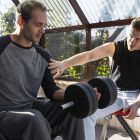Ankle sprain is very common type of ankle injury affecting the ligaments (connective tissues connecting bone to bone for stability) of the ankle. It usually is a result of twisting injury which is often seen in people who play sports, indulge in high impact activities like skiing, hip-hop dance etc or people who wear high heeled shoes most of the times. This twist causes there ligaments to stretch pass their capability thereby causing tearing. Depending on the severity it can be classifeied in 3 grades.
GRADE 1- Mild damage to the ligament (usually a overstretch) resulting in pain, swelling and discomfort without any instability.
GRADE 2- Moderate damage that the ligament partially tears resulting in pain, swelling and discomfort. Unable to bear weight on the foot.
GRADE 3- complete rupture of the ligament resulting in marked bruising and instability in ankle joint.
CAUSES:
- Sports activities which have high probability of ankle twists like basketball, tennis, skateboarding.
- High impact fitness routines like running on uneven surfaces, hip-hop dancing, Salsa dancing.
- Injury like slipping from stairs or twisting of foot on high heels.
- The risk increases in case
- You have weak foot and leg muscles.
- You have flat foot.
- Improper footwear.
- Wearing high heeled shoes.
MYTHS OF ANKLE SPRAIN:
MYTH 1- IF I CAN MOVE MY ANKLE, ITS NOT BROKEN
In many cases ankle sprain results in small fractures on which you can still do partial weight bearing. Visit a professional for better advice.
MYTH 2- BANDAGING HELPS ANKLE SPRAIN
Yes it does! But its just a support at that particular time when you had a sprain to limit the injury and provide support. It does not address or correct the condition.
MYTH 3- SOAKING THE FOOT IN WARM WATER MIXED WITH SALT
It can further aggravate your injury and it’s a bad idea to dip your foot in warm water. Always prefer cold packs in case you sprained your ankle.
MYTH 3- ICING HELPS IN REDUCING SWELLING
Icing alone cannot help in reducing swelling as it has to be drained against gravity and it’s a tough job. Thereby compression along with icing and elevation are important components of the treatment and goes hand in hand.
MYTH 4- WAIT AND DO HOME THERAPY AND ANKLE SPRAIN CAN GET BETTER
The sooner you take the treatment the better it is managed. If we do wrong treatment at home we are slowing down the process of recovery and always remember “feets are the foundation of the body”. We have to be extra cautious in dealing with injuries of foot and ankle.
MYTH 5- IF PAIN GOES AWAY NO FURTHER TREATMENT IS REQUIRED
Once you have a episode of ankle sprain treatment its always important to strengthen your ligaments and muscles as you are always more prone of getting it again. These recurrent sprains becomes more difficult to manage and can result in various foot and ankle problems.
MANAGEMENT OF ANKLE SPRAIN:
- X-RAY- to rule out fracture.
- Physical Examination- to assess ROM and see whether its Inversion (lateral) ankle sprain or eversion (medial) ankle sprain.
- MRI- in case doctor suspects grade 3 injury to rule out the need of surgery.
- Wear a brace (ankle stirrup) to support your ankle.
- Elevating your foot (pillows underneath) to reduce the swelling.
- Cold packs for 10-15 mins every 4 hourly followed by bandaging to manage inflammation and swelling.
- Ultrasonic therapy is of great help in regenerating torn ligaments.
- Avoid putting weight on ankle use crutches in case its an emergency.
- For pain management OTC drugs like pain killers and muscle relaxants can be taken.
- Kinesiotaping helps drain swelling, supports the ankle joint and speeds up your recovery.
- Manual therapy do wonders in grade 1 sprains and some benefits in grade 2 sprain as well.
- Once pain and inflammation settle proper rehabilitation is necessary to avoid the recurrence. This is done with proper strength training and balance training protocols.
- Use of insoles to minimize the risk of further injuries.
- In cases not responding to conservative management do speak with your doctor regarding surgery.
Disclaimer
This information should not be used as a substitute for professional diagnosis and treatment as this is for informational purposes only. One must consult their healthcare provider before making any healthcare decisions. Any damage, loss or injury suffered by an individual as a result of reliance on the information contained on this site is neither the responsibility nor the liability of Orthocure Clinics.





